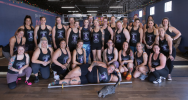BJJ Shawn
Level 6 Valued Member
Christian Thibaudeau goes from snatch first working through progressively more complicated movements (hanging low pulls, high pulls, snatch deadlift, snatch deadlift to pulls, etc.) before moving to the clean and jerk. His explanation:
"Purpose of this phase: The goal for this first day of block one is to start programing the “explosive pull” movement pattern that drives the Olympic lifts.
We are focusing solely on the snatch because once the snatch has been mastered, the clean is very easy to learn. However the opposite is not true: a lot of already strong people who start by learning the clean will tend to “muscle the weight up” and never develop the optimal pattern with the lower body.
The way I teach technique is to teach “feels” on simpler exercises and gradually build them up toward the end goal while always trying to copy the feel from the simpler movement to the next step in complexity.
We will start with a stand-alone movement (snatch-grip power shrug from the hang) to be sure to truly master it and then we eventually will move on to complexes where we combine the simpler exercise with the next step in the same set. This will make it easier to learn the movement without having to focus on technical issues."
"Purpose of this phase: The goal for this first day of block one is to start programing the “explosive pull” movement pattern that drives the Olympic lifts.
We are focusing solely on the snatch because once the snatch has been mastered, the clean is very easy to learn. However the opposite is not true: a lot of already strong people who start by learning the clean will tend to “muscle the weight up” and never develop the optimal pattern with the lower body.
The way I teach technique is to teach “feels” on simpler exercises and gradually build them up toward the end goal while always trying to copy the feel from the simpler movement to the next step in complexity.
We will start with a stand-alone movement (snatch-grip power shrug from the hang) to be sure to truly master it and then we eventually will move on to complexes where we combine the simpler exercise with the next step in the same set. This will make it easier to learn the movement without having to focus on technical issues."

